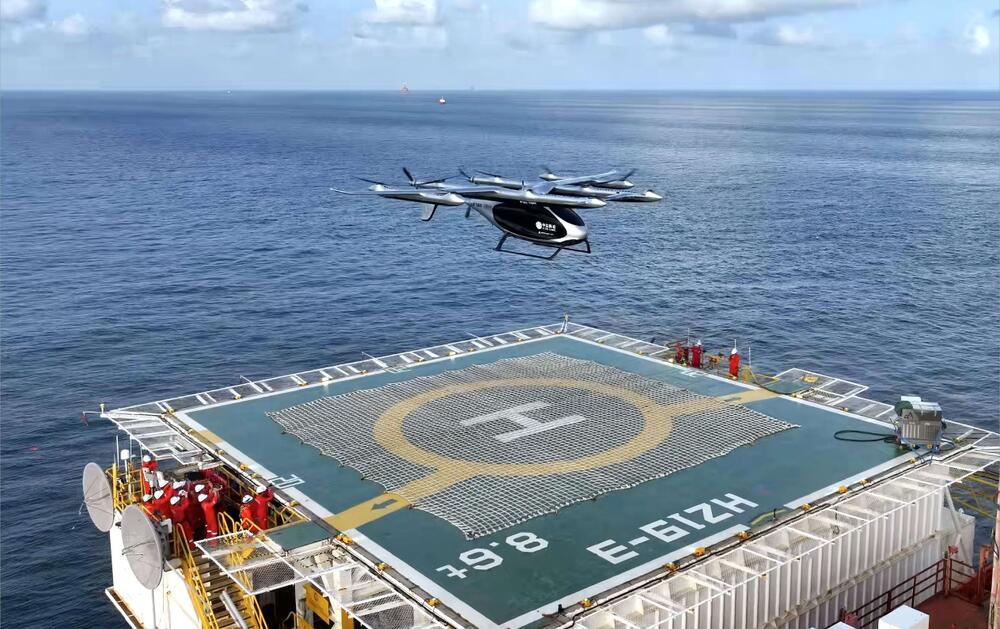
The world’s first cargo flight to an offshore oil platform, conducted by a domestically developed 2-ton electric vertical takeoff and landing (eVTOL) aircraft, demonstrates the immense potential of integrating low-altitude aviation with ocean-based industries, as well as the value of heavy-load eVTOLs in long-distance missions, experts said.
To accelerate the application of eVTOLs in marine scenarios, they emphasized the necessity for design adjustments tailored to marine environments, integration with diverse engineering projects, and technology upgrades for greater performance.
In a vital leap for China’s low-altitude economy, the eVTOL craft, named CarryAll, recently transported fresh fruit and emergency medical supplies from Shenzhen to the Huizhou 19-3 platform, located 150 kilometers off the coast of Shenzhen, slashing transport time from 10 hours to just 58 minutes.
The test flight was part of a joint initiative by China National Offshore Oil Corp, Citic Offshore Helicopter Co, and Autoflight. They jointly announced the breakthrough on Sunday.
For decades, CNOOC relied on slow-moving vessels — a journey of 10 hours per trip — or costly helicopters to transport supplies and personnel. The eVTOL offers a third option: autonomous, fast, and scalable logistics even for platforms with limited landing space.
“This successful flight breaks the traditional time constraints of offshore logistics and offers new possibilities for emergency supply and maritime engineering support,” said Yang Daqing, secretary-general of the port and shipping supply chain branch of the China Federation of Logistics and Purchasing. “It’s a major step in integrating low-altitude aviation into ocean-based industries.”
Wang Guowen, director of the center for logistics and supply chain management at Shenzhen-based think tank, the China Development Institute, highlighted that CarryAll’s hybrid fixed-wing and rotor design enhances energy efficiency, enabling low-cost air transport and addressing traditional eVTOL limitations in range and payload.
He added that this hybrid configuration is an important direction for the future development of low-altitude transportation, whether for cargo or passenger transport.
Notably, CarryAll is the world’s first eVTOL over one metric ton to receive a type certificate, production license, and individual airworthiness certificate. Featuring a composite wing, it boasts a range of 200 kilometers, a top speed of 200 kilometers per hour, and a payload capacity of 400 kilograms.
ALSO READ: 'Blue sky' powerhouse taking off
According to Xie Jia, senior vice-president at Autoflight, the aircraft passed key reliability tests, including hovering, cross-sea navigation, and vertical takeoff and landing, so as to better adapt to the South China Sea’s challenging environment, characterized by high salt spray, humidity, and strong gusts.
This landmark flight follows a strategic agreement signed in April between CITIC Offshore Helicopter, Citic Financial Leasing, and Autoflight, which includes an intent to purchase 100 large eVTOL aircraft, including the 2-ton CarryAll.
According to estimates by the Civil Aviation Administration of China, the low-altitude economy could reach 3.5 trillion yuan ($480 billion) by 2035, and innovative applications in marine environments are expected to be an important growth driver.
China’s 20,000-kilometer coastline and growing offshore infrastructure create strong demand for fast, flexible aerial logistics, Yang said. He believes that offshore oil and gas, marine petrochemicals, desalination, and coastal mining are among the sectors that could benefit most from scaled-up eVTOL deployment.
In his view, CarryAll has delivered strong performance in payload capacity, transportation timeliness, and range during this mission, extending the application of low-altitude transport into maritime scenarios and further expanding the potential of the low-altitude economy.
In future maritime logistics missions, Yang said he hopes that this type of eVTOL will focus on the transportation of high-value and quickly needed items, working in synergy with unmanned vessels.
Both Wang and Yang emphasized that achieving commercial viability of such heavy-load eVTOLs requires scale, regulatory support, and infrastructure investment. Greater usage lowers per-unit costs and accelerates business conversion. This necessitates collaboration with industrial clusters to build a high-frequency, high-efficiency logistics ecosystem, Yang said.
He called for necessary adjustments of eVTOL infrastructure to accelerate their applications in maritime logistics. “Charging networks, satellite navigation, and maintenance stations must also adapt to offshore conditions.”
Regarding heavy-load eVTOLs as a vital development direction for the low-altitude economy, Wang highlighted their potential for intercity logistics and rural connectivity, especially in vast inland regions. He suggested technical improvements in battery technology and aircraft structure for achieving safer, more stable and efficient flight.
READ MORE: Low-altitude economy attracts more aero firms
He encouraged related enterprises to expand markets beyond the Guangdong-Hong Kong-Macao Greater Bay Area, particularly in the vast northwestern region of the country, where counties and townships are often hundreds of kilometers apart and eVTOLs could serve as an excellent transportation solution.
Chen Yang and Fan Feifei contributed to this story.


